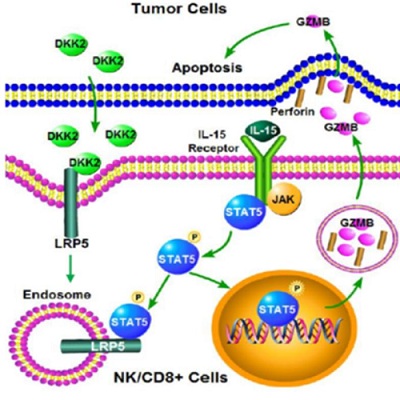On Feb. 12th, Nature Medicine published online a work entitled “DKK2 imparts tumor immunity evasion through b-catenin independent suppression of cytotoxic immune cell activation” from a collaborative research team of Dr. Dianqing Wu from Yale School of Medicine and Dr. Lin Li from Shanghai Institute of Biochemistry and Cell Biology, Chinese Academy of Sciences. Dr. Dianqing Wu is also a guest professor of the Institute of Biochemistry and Cell Biology. This work identified a previously unknown tumor immune suppressive mechanism mediated by DKK2, allowing for the development of new immunetherapeutical strategies particularly relevant for CRCs and a subset of melanomas.
In the past decades, remarkable advances in immunotherapy have been made in cancer treatment. Immune checkpoint inhibitors, including anti-PD1, anti-CTLA4, and others in development, have shown clinical efficacy for a number of tumors, including advanced melanoma, but they do not appear to be efficacious for colorectal cancer (CRC). Surgery combined with chemotherapy/radiotherapy remain the current major treatment for CRC patients, which however lacks effectiveness and causes great mains and poor survival rate to the patients.
In this joint work, the researchers found that CRC tumor microsatellitestabllity correlates closely with patient survival rate. In CRC, microsatellitestable (MSS) group shows a poorer prognosis compared to the microsatellite-instable (MSI) group. More than 80% of CRCs are microsatellitestable and the Wnt antagonist DKK2 expression in MSS CRCs is found to be significantly higher than that in MSI CRCs. In ApcMin/+ mice, a mouse model for intestinal tumorigenesis, the DKK2 mRNA content in the intestinal polyps is increased dramatically compared to that in normal intestines. In line with this, deficiency of DKK2 significantly reduces intestinal polyp burdens and leads to suppression of tumor progression in mouse models. Further studies revealed that CRCs upregulate DKK2 expression, which promotes tumor progression by suppressing immune effector cell activation via LRP5 in a β-catenin-independent manner. Overall, these findings unravel a new mechanism for tumor immune evasion and identified DKK2 as a new target for immunotherapy.
This study is supported by grants from the Strategic Priority Research Program of CAS and the National Natural Science Foundation of China.
AUTHOR CONTACT:
Dianqing Wu, Ph.D., Professor
Department of Immunobiology, Yale School of Medicine, New Haven, CT 06520.
Email: dan.wu@yale.edu
Lin Li, Ph.D., Professor
State Key Laboratory of Molecular Biology, CAS Center for Excellence in Molecular Cell Science, Innovation Center for Cell Signaling Network, Institute of Biochemistry and Cell Biology, Shanghai Institutes for Biological Sciences, Chinese Academy of Sciences, University of Chinese Academy of sciences, Shanghai 200031, China.

Figure. A model for the function of DKK2 in imparting tumor immunity evasion. CRCs upregulate the expression of DKK2, which inhibits STAT5 signaling by impeding STAT5 nuclear localization via LRP5.

 Appendix:
Appendix: